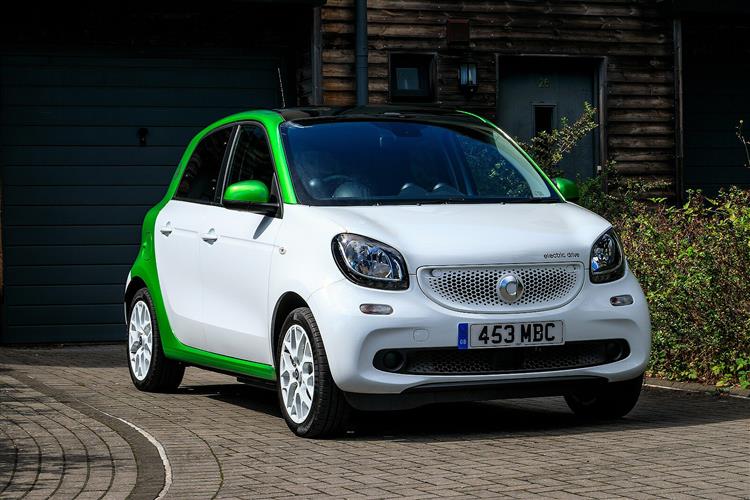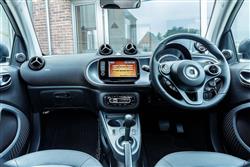MORE OF A FORFOUR (some text hidden) SECTIONED_new_smartforfour_2015
By Jonathan Crouch
Introductionword count: 122
In the city car segment if you're looking at cars from the second half of this century's second decade, there's nothing quite like a smart forfour. That might sound a strange thing to say, given that this car borrows so much, both from the brand's smaller fortwo model and from its Renault Twingo design stablemate. These ingredients though, were here put together with care and flair to create quite an aspirational, premium choice in this class. There's a price to pay for this of course, but it's not exorbitant and the issues of practicality, efficiency and connectivity have all been very cleverly thought through. In short, if you're shopping in this segment for a car from this era, you'd probably like one.
Modelsword count: 9
Models Covered : (4dr city car 1.0 petrol, EV])
Historyword count: 422
Like the idea of smart's fashionable little fortwo, but need more than two seats? Then you'll like this, the brand's five-door forfour, which arrived in second generation form in 2015. Still concentrated smart, still clever, still small - but just that little bit more usable. What do you do when your brand is completely defined by one single car? Broaden it with a whole range of completely different products? That tends not to work, as smart found out when it launched the original version of this forfour model back in 2004. This, a Mitsubishi Colt in a smart body kit, wasn't actually very 'smart' at all: no rear-engined layout: no super-tight turning circle. It wasn't even particularly small. In short, what was served up back then delivered a conspicuous lack of the things that ought to have defined this clever, fashionable urban brand. But in 2015, we were served up a four-seater smart model much more suited to its brand's dinky urban values. This car was what its predecessor should have been: a fortwo with two extra seats. So the engine was in the back, it turned on a sixpence like a London taxicab and you could fit it into spaces you'd regretfully pass by at the wheel of an ordinary supermini. That's partly because, unlike its predecessor, this forfour wasn't an ordinary supermini, in second generation form sized instead to compete against smaller city cars like Hyundai's i10, Fiat's Panda and the various permutations of Peugeot's 108 and the Volkswagen up! It was a tough sales environment, hence the importance of that uniquely space-efficient rear-engined layout, a set-up that virtually every other manufacturer had back in 2015 considered - and then rejected - for use in this segment. With this in mind - and having already burnt its fingers by getting the first generation version of this car wrong - it was perhaps not surprising that smart owner Daimler sought to hedge its financial bets by developing this design in partnership with another brand - Renault the chosen one. Hence the reason why this model shared almost everything with the third generation version of the French maker's Twingo citycar - except perhaps a uniquely smart-orientated sense of style and joie de vivre. That's important. This car needed a brand identity, an appeal to heart as well as head. But it wasn't enough to make it sell as Daimler wanted. Combustion-powered forfour models were offered until 2019, after which an all-electric EQ model took over until the end of sales in 2023.
What You Getword count: 819
A smart needs to look like one - as this forfour does. So there's the familiar distinctive outline of the tridion safety cell as part of the usual fashionable two-tone paint finish. And a design that's pretty much identical to that of the brand's smaller fortwo model from the A-pillars forward. Basing this car on smart's tiniest offering meant that this second generation forfour had to be a size smaller than it was in MK1 model guise, city car rather than supermini-shaped. In fact, it's very small indeed, the mere 350cm length making this five-door design actually more compact than three-door city cars of the period like Fiat's 500 and Ford's Ka. Indeed, it's only 80cms longer than the miniscule fortwo. To facilitate this, the bonnet's tiny, helping with a turning circle that's tighter than that of a taxi. Such are the benefits of smart's decision to put the engine in the rear. Being rear-engined defines this 3.5-metre-long car in other ways too. With no oily bits at the pointy end, the front wheels can be pushed right to the corners, which improves stability - as well as increasing cabin space to such an extent that the interior of this forfour is virtually as big as that of a Fiesta-sized supermini from the next class up. As a result, some hailed this design as one of the most significant small runabouts we'd seen since the original Mini. Its smartly fashionable inside too, the dashboard a two-piece affair, with the upper part trimmed in a lovely mesh-effect fabric coating that looks great, though we wouldn't want to have to try and get melted chocolate out of it. This could be colour-co-ordinated by original buyers alongside the central seat facings and the middle panels in the doors, with orange, blue or black themes, depending on the model chosen. Most eyes though, will be drawn towards the centre console, particularly in a plush model fitted with the brand's clever smart Media-System with its 7-inch touchscreen display and 3D navigation set-up. Otherwise, your main tools of operating functionality are housed in the semi-circular binnacle you view through the three-spoke leather-trimmed multi-function steering wheel. Outside, the tailgate stretches right down to bumper level - and the area where the engine is housed. Ah yes, that engine. We keep coming back to that don't we? It's been ingeniously mounted at a 49-degree angle that not only stops it intruding into the cargo area but also means that in a rear-end collision, the mechanicals will be pushed beneath the passenger cell. All well and good, but it's still dominates the back end, taking up boot space and making the cargo area floor higher than it would otherwise be. Hotter than it would otherwise be too: we'd advise you to transport ice cream and frozen goods back from the supermarket in the front passenger footwell. You might need to do that anyway, for in standard configuration, you've only got 185-litres of space to play with in the boot, about 25% less than is offered by many segment rivals and even 35-litres less than you'd get in the little fortwo! Stay with us though, for from here on in, the news gets much better, thanks to a combination of clever design and the packaging freedom that the rear-engined configuration allows. Let's start with the way that you can tilt the rear seatback to a more vertical 'cargo' position, a simple action that increases your luggage capacity to 215-litres, providing you can persuade rear seat folk to put up with a little extra discomfort. Where this forfour really shows its versatility though, is when you push forward the standard 50:50 split-folding rear bench. It's not just that the 975-litre capacity this reveals is better than most other cars in this segment. It's also the sheer usability of the beautifully flat space, emphasised primarily by the fitment of an almost unique feature in this class of car - a fold-flat front passenger seat. Thanks to this, astonishingly long loads of up to 2.20-metres in length can be accommodated - say a full-sized double base or an adult bike. Or, according to smart, you could accommodate two of IKEA's 2.12m-long 'Billy' shelves, as well as one metre-high yucca plant and four small boxes. All this in a citycar! Something else we really like (a feature not included on this car's Renault Twingo design stablemate) is the 'Readyspace' rear seat bases. If you've a taller item to carry and it needs to be transported upright - say a tall plant or a piece of delicate electrical equipment - you can flip the bases over so that the seat squab sits lower to the floor. And if said item is wide and bulky, you can remove the centre storage compartment too. Once you've done that, a 42-inch packaged flatscreen TV could be transported. No other car in this class can do all this.
To see the full road test text contact us on 0330 0020 227
Pictures (high res disabled)

.jpg)
|
.jpg)
|
.jpg)
| |||
.jpg)
|
.jpg)
|
.jpg)
| |||
.jpg)
|
.jpg)
|
.jpg)
| |||
.jpg)
|
.jpg)
|

|
Scoring (subset of scores)
Category: Small Runabouts
| Performance | |
| Handling | |
| Comfort | |
| Space | |
| Styling, Build, Value, Equipment, Depreciation, Handling, Insurance and Total scores are available with our full data feed. | |



